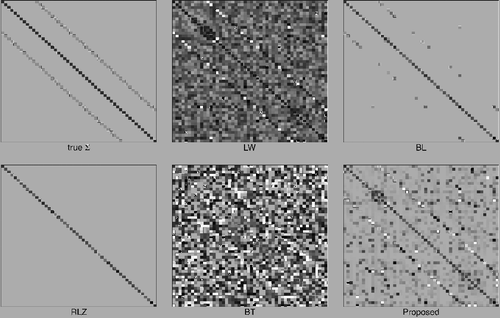Figures & data
Table 1. Performance comparison for Scenario 1 (Compact Banded Structure). Averages of measures from 200 replicates are listed with parentheses indicating their standard errors.
Table 2. Performance comparison in Scenario 2 (Permuted Banded Structure). Averages of measures from 200 replicates are listed with parentheses indicating their standard errors.
Figure 1. Heat maps of the true covariance matrix and various estimates from one replicate of simulations in Scenario 3. Absolute values of entries are used to replace original entries. An entry of magnitude 1 or over is represented by a black square and an entry of magnitude 0 is represented by a white square.

Table 3. Performance comparison in Scenario 3 (Loose Banded Structure). Averages of measures from 200 replicates are listed with parentheses indicating their standard errors.
Table 4. Performance comparison in Scenario 4 (Block Diagonal Structure). Averages of measures from 200 replicates are listed with parentheses indicating their standard errors.
Table 5. Performance comparison in Scenario 5 (Permuted Block Diagonal Structure). Averages of measures from 200 replicates are listed with parentheses indicating their standard errors.
Figure 2. Heat maps of the true covariance matrix and various estimates from one replicate of simulations in Scenario 5. Absolute values of entries are used to replace original entries. An entry of magnitude 1 or over is represented by a black square and an entry of magnitude 0 is represented by a white square.

Table 6. Performance comparison in Scenario 6 (Dense Structure). Averages of measures from 200 replicates are listed with parentheses indicating their standard errors.
Table 7. Summary of realised returns of portfolios built with different covariance matrix estimates.
